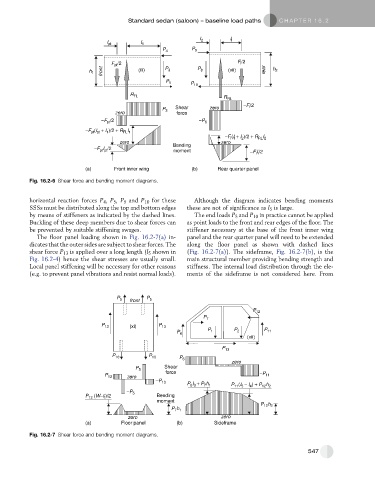Page 538 - Automotive Engineering Powertrain Chassis System and Vehicle Body
P. 538
Standard sedan (saloon) – baseline load paths C HAPTER 16.2
I 2 I l
I pt I 1
P 4 P 9
F /2 F /2
l
pt
front
h (iii) P 3 P 8 (vii) rear h 2
1
P 5 P 10
R FL R RL
/2
−F l
P Shear zero
zero 3 force
−F pt /2 −P 8
(I + I )/2 + R I
−F pt pt 1 FL 1
−F (I + I )/2 + R I
2
RL 2
l l
zero zero
Bending
−F I /2 moment −F I /2
pt pt
l l
(a) Front inner wing (b) Rear quarter panel
Fig. 16.2-6 Shear force and bending moment diagrams.
horizontal reaction forces P 4 ,P 5 ,P 9 and P 10 for these Although the diagram indicates bending moments
SSSs must be distributed along the top and bottom edges these are not of significance as l 5 is large.
by means of stiffeners as indicated by the dashed lines. The end loads P 5 and P 10 in practice cannot be applied
Buckling of these deep members due to shear forces can as point loads to the front and rear edges of the floor. The
be prevented by suitable stiffening swages. stiffener necessary at the base of the front inner wing
The floor panel loading shown in Fig. 16.2-7(a) in- panel and the rear quarter panel will need to be extended
dicates that the outer sides are subject to shear forces. The along the floor panel as shown with dashed lines
shear force P 13 is applied over a long length (l 5 shown in (Fig. 16.2-7(a)). The sideframe, Fig. 16.2-7(b), is the
Fig. 16.2-4) hence the shear stresses are usually small. main structural member providing bending strength and
Local panel stiffening will be necessary for other reasons stiffness. The internal load distribution through the ele-
(e.g. to prevent panel vibrations and resist normal loads). ments of the sideframe is not considered here. From
P 5 front P 5
P 12
P 7
P 13 (xi) P 13
P 6 P 1 P 2 P 11
(xii)
P 13
P 10 P 10 P 6
zero
P 5 Shear
P 13 zero force −P 11
−P 13 P I + P h P (I − I ) + P h
7 1
6 3
−P 5 11 5 4 12 2
P (W−t )/2 Bending
13
f
moment
P 12 h 2
P h
7 1
zero zero
(a) Floor panel (b) Sideframe
Fig. 16.2-7 Shear force and bending moment diagrams.
547

